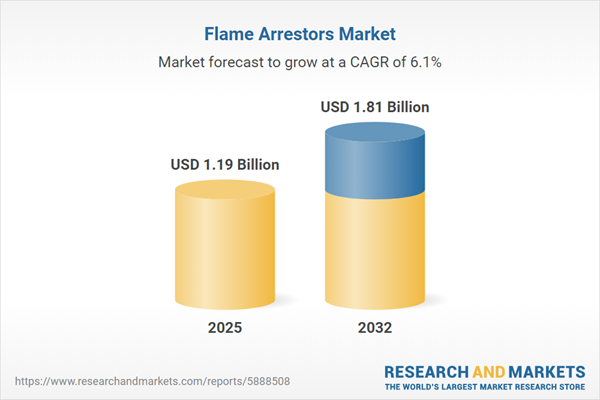Speak directly to the analyst to clarify any post sales queries you may have.
Flame arrestors are essential to maintaining safety and regulatory confidence across industrial sectors. As senior executives prioritize resilient and compliant operations, robust flame arrestor technologies help mitigate risks, support continuity, and sustain trust in demanding environments.
Market Snapshot: Trends and Opportunities in the Flame Arrestors Market
The global flame arrestors market is valued at USD 1.12 billion in 2024 and is projected to reach USD 1.81 billion by 2032, reflecting a CAGR of 6.12%. Market expansion is driven by the adoption of advanced protection strategies and increased implementation of digital risk monitoring. Regulatory landscapes are evolving rapidly, prompting organizations to seek solutions that not only fulfill compliance standards but also ensure operational dependability. These trends are particularly evident where regulations are frequently updated, requiring agile responses from decision-makers across both mature and emerging regions.
Scope & Segmentation of the Flame Arrestors Market
Thorough segmentation in the flame arrestors market enables organizations to direct investments to the most relevant compliance and risk management priorities. Targeted solutions address a wide range of operational and regulatory challenges:
- Application Areas: Flame arrestors are utilized in chemical manufacturing, oil and gas, food and beverage processing, pharmaceuticals, power generation, and shipbuilding—each facing distinct regulatory standards and safety complexities.
- Product Types: Options include ceramic arrestors suited for high temperatures, sintered metal arrestors for performance in demanding environments, and wire mesh variants designed for compact or flexible system requirements.
- Material Choices: Commonly selected materials range from lightweight aluminum for scalable installations, to nickel-based alloys offering corrosion resistance, and stainless steel preferred for ongoing maintenance and longevity.
- Flow Direction: Solutions are available in both bidirectional and unidirectional formats, supporting variable pipeline configurations in different facilities.
- Regional Markets: Adoption is shaped by specific compliance frameworks, with the Americas, Europe, Middle East and Africa, and Asia-Pacific exhibiting unique market drivers and levels of maturity.
- Key Companies: Notable providers—including Emerson Electric Co., Honeywell International Inc., Baker Hughes Company, Schlumberger Limited, KROHNE Group, ERIKS NV, Inpro/Seal LLC, DonTech, Inc., Flair-Flo Equipment Corporation, and CECO Environmental Corp.—inform industry direction and innovation.
- Technological Innovations: High-performance ceramics and sintered metals are increasingly combined with digital monitoring for improved operational transparency and compliance tracking.
Key Takeaways for Senior Decision-Makers
- Modular flame arrestor designs facilitate adaptation to diverse facility layouts, supporting rapid integration and streamlined compliance response.
- Incorporating advanced analytics within flame arrestors enhances early detection of process deviations and fosters a proactive safety culture.
- Partnering with manufacturers adept in digital technologies strengthens organizational responsiveness during changes in production or supply chain disruptions.
- Selecting materials and designs aligned with evolving operational conditions and regulatory shifts aids in maintaining long-term reliability.
- Collaborative approaches with solution providers and industry partners advance risk mitigation and foster comprehensive safety strategies across critical infrastructure.
Tariff Impact: Navigating Global Trade and Cost Pressures
Recent U.S. tariff policy changes have led flame arrestor manufacturers and suppliers to reassess sourcing and production strategies. This shift places a stronger emphasis on localizing supply chains and utilizing materials that reinforce system resilience. Such strategic realignment helps to better manage costs, while enabling organizations to apply emerging material technologies and enhance adaptability within changing global market conditions.
Methodology & Data Sources
This report integrates insights from technical publications, regulatory audit outcomes, and patent analysis. It is further strengthened by input from industry specialists and application consultants with direct experience in technology adoption and implementation across varied facility operations.
Why This Report Matters
- Provides actionable recommendations to align investments with shifting compliance requirements and the latest flame arrestor technologies.
- Enables leaders to evaluate supplier capabilities and manage operational risks more effectively within regulated industrial environments.
- Helps organizations reinforce sourcing and supply chain strategies, ensuring rapid adaptation to compliance changes and market volatility.
Conclusion
Industry decision-makers gain the clarity needed to reconcile regulatory demands with operational strategies. Advanced flame arrestor technologies empower leaders to proactively manage risks and optimize safety protocols as the industry landscape evolves.
Additional Product Information:
- Purchase of this report includes 1 year online access with quarterly updates.
- This report can be updated on request. Please contact our Customer Experience team using the Ask a Question widget on our website.
Table of Contents
3. Executive Summary
4. Market Overview
7. Cumulative Impact of Artificial Intelligence 2025
Companies Mentioned
The companies profiled in this Flame Arrestors market report include:- Emerson Electric Co.
- Honeywell International Inc.
- Baker Hughes Company
- Schlumberger Limited
- KROHNE Group
- ERIKS NV
- Inpro/Seal LLC
- DonTech, Inc.
- Flair-Flo Equipment Corporation
- CECO Environmental Corp.
Table Information
| Report Attribute | Details |
|---|---|
| No. of Pages | 185 |
| Published | November 2025 |
| Forecast Period | 2025 - 2032 |
| Estimated Market Value ( USD | $ 1.19 Billion |
| Forecasted Market Value ( USD | $ 1.81 Billion |
| Compound Annual Growth Rate | 6.1% |
| Regions Covered | Global |
| No. of Companies Mentioned | 11 |









